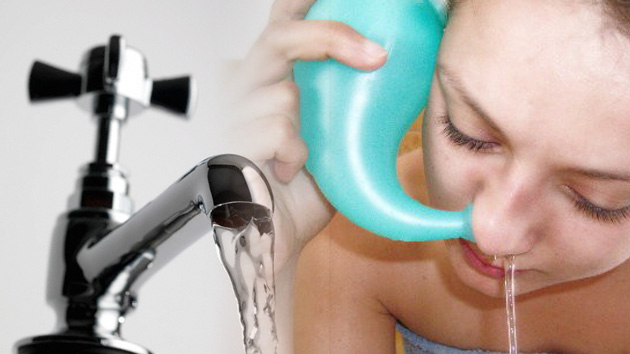Along with other nasal irrigation systems, these devices use a saline, or saltwater, solution to treat congested sinuses, colds, and allergies. They're also used to moisten nasal passages exposed to dry indoor air.
The concept of nasal flushing is pretty simple. The spout of the neti pot is placed in one nostril and the head is tilted at about a 45 degree angle so the other nostril is lower. The pot is held high and the salty water flows in one nostril and out of the other, flushing out any debris with it.
These nasal rinse devices — which include bulb syringes, squeeze bottles, and battery-operated pulsed water devices — are usually safe and effective products when used and cleaned properly, says Eric A. Mann, MD, PhD, a doctor at FDA.
But using the wrong type of water for irrigation and/or improper cleaning of the devices can lead to serious infections - including some that are deadly, including Naegleria fowleri - better known as the "brain-eating" amoeba.
Researchers believe that two deaths in 2011 were caused by brain-eating amoebae that made its way into the victims' tap water, reports CBS:
The amoeba causes Primary Amebic Meningoencephalitis (PAM), which is a severe brain infection.Normally, people get the infection after swimming in warm freshwater lakes and rivers because the amoeba flourishes in those warm conditions. However, the two victims, a 28-year-old male and 51-year-old woman from Louisiana, had not been around freshwater. The man and woman used tap water in their neti pots.
The victims' home plumbing systems were tested and came back positive for the amoeba, but the city water distribution systems tested negative. Naegleria fowleri was found in the woman's bathroom sink and faucet tub, and it was in a tankless water heater in the man's home.
The investigation was published in August 22 issue of Clinical Infectious Diseases.
According to the Centers for Disease Control and Prevention (CDC), Naegleria fowleri infections are rare, but they are usually fatal:
Tap water isn't safe for use as a nasal rinse because it's not adequately filtered or treated. Some tap water contains low levels of organisms — such as bacteria and protozoa, including amoebas — that may be safe to swallow because stomach acid kills them. But these organisms can stay alive in nasal passages and cause potentially serious infections.In the 10 years from 2006 to 2015, 37 infections were reported in the U.S. Of those cases, 33 people were infected by contaminated recreational water, 3 people were infected after performing nasal irrigation using contaminated tap water, and 1 person was infected by contaminated tap water used on a backyard slip-n-slide. The fatality rate is over 97%. Only 3 people out of 138 known infected individuals in the United States from 1962 to 2015 have survived.
The FDA offers the following tips for safe neti pot use.
What Types of Water Are Safe to Use?
- Distilled or sterile water, which you can buy in stores. The label will state "distilled" or "sterile."
- Boiled and cooled tap water. Boiled water for 3 to 5 minutes, then cool until it is lukewarm. Previously boiled water can be stored in a clean, closed container, but use it within 24 hours.
- Water passed through a filter designed to trap potentially infectious organisms. CDC has information on selecting these filters.
Mann explains:
There are various ways to deliver saline to the nose. Nasal spray bottles deliver a fine mist and might be useful for moisturizing dry nasal passages. But irrigation devices are better at flushing the nose and clearing out mucus, allergens and bacteria.Follow the instructions that came with your device, as they may provide more specific instructions about its use and care.
The devices all work in basically the same way, according to the FDA:
- Leaning over a sink, tilt your head sideways with your forehead and chin roughly level to avoid liquid flowing into your mouth.
- Breathing through your open mouth, insert the spout of the saline-filled container into your upper nostril so that the liquid drains through the lower nostril.
- Clear your nostrils. Then repeat the procedure, tilting your head sideways, on the other side.
If your immune system isn't working properly, the FDA recommends consulting with your health care provider before using any nasal irrigation systems.
To use and care for your device, the FDA recommends the following:
- Wash and dry your hands.
- Check that the device is clean and completely dry.
- Prepare the saline rinse, either with the prepared mixture supplied with the device, or one you make yourself.
- Follow the manufacturer's directions for use.
- Wash the device, and dry the inside with a paper towel or let it air dry between uses.
Naegleria fowleri symptoms typically start 1-9 days (median 5 days) after exposure, and can mirror bacterial meningitis, which can make diagnosis tricky. This is unfortunate, because the disease progresses rapidly - so rapidly, in fact, that diagnosis is usually made after death.
Death occurs within 1 - 18 days (median 5 days) after symptoms begin.
Individuals usually become infected while swimming in warm fresh water. The amoeba enters the nose and then travels to the brain, where it causes swelling and tissue death.
Signs and symptoms of infection include:
- Stage 1
- Severe frontal headache
- Fever
- Nausea
- Loss of appetite
- Vomiting
- Stage 2
- Stiff neck
- Seizures
- Altered mental status
- Hallucinations
- Coma




Comment: See also: